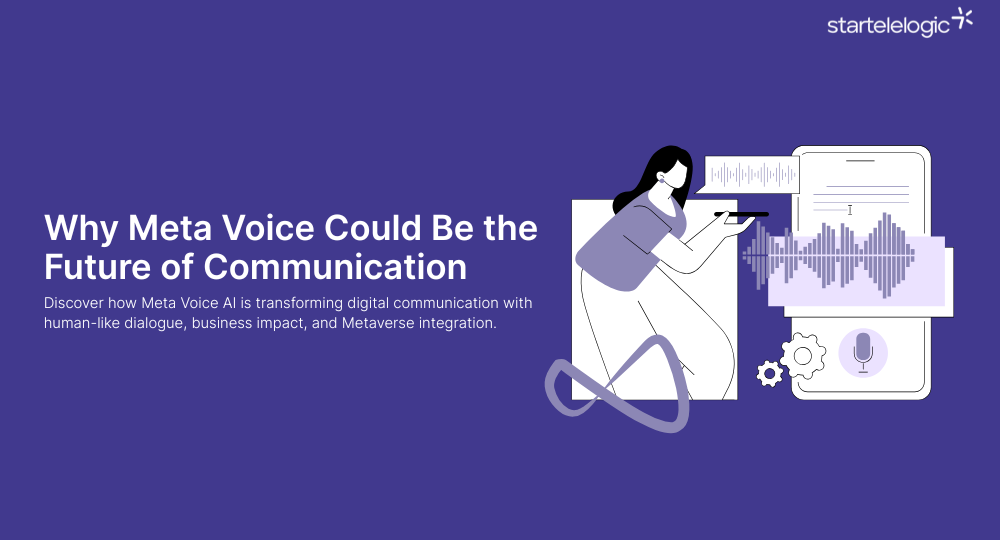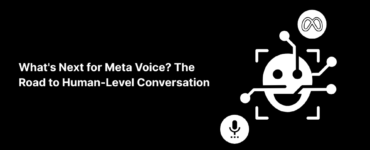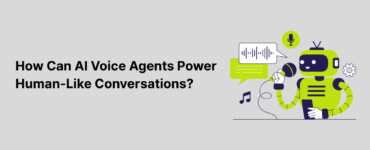The global digital communication landscape is evolving at a rapid pace. Analysts forecast the worldwide voice AI market will exceed $50 billion by 2030, growing at a CAGR of more than 20%. Already, Statista reports that voice assistants like Alexa, Siri, and Google Assistant are handling 4.2 trillion voice interactions annually. This massive growth shows that voice-driven platforms are no longer optional; they are the future of human-technology interaction.
Among the companies leading this revolution is Meta, with its groundbreaking Meta Voice AI. This advanced technology blends natural speech recognition, contextual intelligence, and AI-powered responses to create communication that feels almost human. It is not just a tool; it represents a fundamental shift in how people, businesses, and even digital avatars will interact.
What is Meta Voice AI?
Meta Voice AI is a communication technology developed by Meta that enables people to interact with machines through natural dialogue. Unlike traditional voice assistants that follow simple commands, Meta Voice supports dynamic, context-aware, and emotionally intelligent conversations.
The idea is simple: instead of tapping, typing, or navigating through screens, users can just talk — the way they would with another person. Meta Voice not only understands words but also picks up on tone, intent, and mood, which makes conversations feel more natural and engaging.
This approach turns interaction with technology from something mechanical into something meaningful. It opens the door to more human-like digital experiences — where AI doesn’t just process requests, but truly understands and adapts to the way people communicate.
How Meta Voice Technology Works
The real strength of Meta Voice AI lies in how seamlessly it mirrors the natural rhythm of human communication. This is achieved through several tightly connected processes working in harmony:
1. Speech Recognition
State-of-the-art recognition models accurately convert spoken language into text—even when dealing with diverse accents, dialects, or noisy environments. The system doesn’t just hear words; it understands them with remarkable precision.
2. Contextual Intelligence
Meta Voice goes beyond simple transcription. It grasps meaning and intent. For instance, if someone says, “Book me a table for two,” the system infers that this is a restaurant reservation request and accounts for details like time, date, and availability—just like a human assistant would.
3. Intelligent Response Generation
Powered by advanced deep learning and natural language processing, Meta Voice crafts responses that feel fluid, thoughtful, and human-like. Instead of delivering stiff, robotic replies, it adapts tone, style, and phrasing to match the flow of the conversation.
4. Human-Quality Voice Output
Finally, the interaction is voiced through highly realistic speech synthesis. Meta Voice doesn’t just read words aloud—it adds emotional nuance, natural pacing, and subtle emphasis. The result is a voice that sounds alive, capable of engaging users in a way that feels authentic and effortless.
Why Meta Voice Could Be the Future of Communication
Human-Centered by Design
People speak nearly four times faster than they type — around 150 words per minute compared to just 40 when typing. Meta Voice AI taps directly into this natural rhythm of communication, making interactions faster, more intuitive, and frictionless. Instead of adapting to technology, people can simply speak the way they already do.
Breaking Down Accessibility Barriers
More than 770 million people worldwide face literacy challenges, according to UNESCO. Traditional digital communication tools leave many of them behind. Voice, however, is universal — it transcends reading and writing skills. By enabling effortless interaction through speech, Meta Voice AI opens the digital world to millions who have been excluded, making communication more inclusive than ever before.
Driving Business Transformation
The shift to AI-powered voice is not just a trend — it’s a business imperative. Deloitte reports that 80% of global enterprises plan to adopt voice AI for customer engagement within three years. Meta Voice AI enables organizations to provide customer service, sales assistance, and real-time support in a natural, human-like way. The result: deeper trust, stronger loyalty, and a competitive edge in an increasingly conversational marketplace.
For a deeper look at how voice AI is already transforming industries like customer engagement and contact centers, you can read this detailed article: Meta Voice in the Contact Center Industry
Fueling the Metaverse
In immersive environments, text feels clunky and artificial. For the Metaverse to succeed, interactions must feel as real as face-to-face conversations. Meta Voice AI powers this transformation, allowing avatars to speak naturally, connect authentically, and make virtual spaces feel alive. It’s not just a feature — it’s a cornerstone of the Metaverse vision.
Always Learning, Always Improving
Unlike static voice assistants, Meta Voice AI is dynamic. It evolves with each interaction, remembers user preferences, adapts to communication styles, and continuously refines its capabilities. Over time, every conversation becomes more personalized, more efficient, and more human.
The Future of Meta Voice: What Lies Ahead
The future of Meta Voice is rapidly unfolding, with innovations that will make conversations with machines feel as natural—and as human—as those we share with one another. By 2035, experts predict that more than 70% of digital interactions worldwide will be voice-first, reshaping how we connect, create, and collaborate.
Several breakthroughs are set to define this evolution:
- Emotionally Intelligent Dialogue – Advances in vocal analysis will allow AI to detect subtle shifts in tone, intent, and mood, enabling responses that feel empathetic, personal, and deeply human.
- Instant Global Translation – Conversations will flow seamlessly across languages, erasing communication barriers in real time and fostering a truly borderless digital society.
- Immersive Metaverse Integration – In virtual worlds, Meta Voice will power lifelike conversations between avatars, amplifying presence and realism in social, professional, and creative spaces.
- Unified Cross-Platform Experiences – Whether on mobile, web, AR, or VR, Meta Voice will provide a continuous, adaptive layer of communication—always learning, always evolving.
Together, these advances point toward a future where voice is not just a tool but the foundation of digital interaction. Meta Voice won’t simply respond to us—it will understand us, accompany us, and expand what it means to communicate in an increasingly interconnected world.
Final Thoughts
The digital world is moving beyond the era of screens and keyboards. Meta Voice AI marks a pivotal shift toward communication that feels more seamless, intuitive, and human.
Its potential stretches far beyond convenience—it redefines how businesses engage with customers, how individuals connect with technology, and how communities will interact within the Metaverse. With continuous learning and increasingly sophisticated conversational abilities, Meta Voice isn’t just another tool; it is an emerging force that will fundamentally reshape the way we communicate.
What once seemed like a distant future is already taking shape. Organizations and individuals who adopt Meta Voice today won’t just keep pace with change, they will set the standard for a world where voice, not text, becomes the primary language of digital connection.
Frequently Asked Questions (FAQs)
Q1: What is Meta Voice AI?
Meta Voice AI is an advanced voice technology developed by Meta that allows users to have natural, human-like conversations with artificial intelligence. It goes beyond simple commands by understanding context, emotion, and intent.
Q2: How does Meta Voice technology improve communication?
Meta Voice technology makes communication faster, more natural, and more inclusive. By converting speech into meaningful responses, it reduces the need for typing, supports accessibility, and enables human-like conversations with AI.
Q3: What are the real-world applications of Meta Voice AI?
Meta Voice AI can be applied in customer service, healthcare, education, entertainment, and smart home management. Businesses can use it for customer engagement, while individuals can benefit from everyday lifestyle tasks.
Q4: Why is Meta Voice considered the future of communication?
Meta Voice is seen as the future of communication because it blends natural speech recognition, AI-driven understanding, and lifelike voice output. This combination makes interactions more human, faster, and adaptable across industries and even the Metaverse.
Q5: How will Meta Voice AI impact businesses?
Businesses can use Meta Voice AI to provide 24/7 customer support, handle sales queries, and create personalized experiences. Studies show that over 80% of businesses plan to integrate voice AI into their customer engagement strategies within the next few years.
Q6: What role will Meta Voice play in the Metaverse?
In the Metaverse, Meta Voice communication will allow avatars to speak in real time, making digital interactions more immersive and realistic. This is key to creating lifelike, interactive virtual environments.




